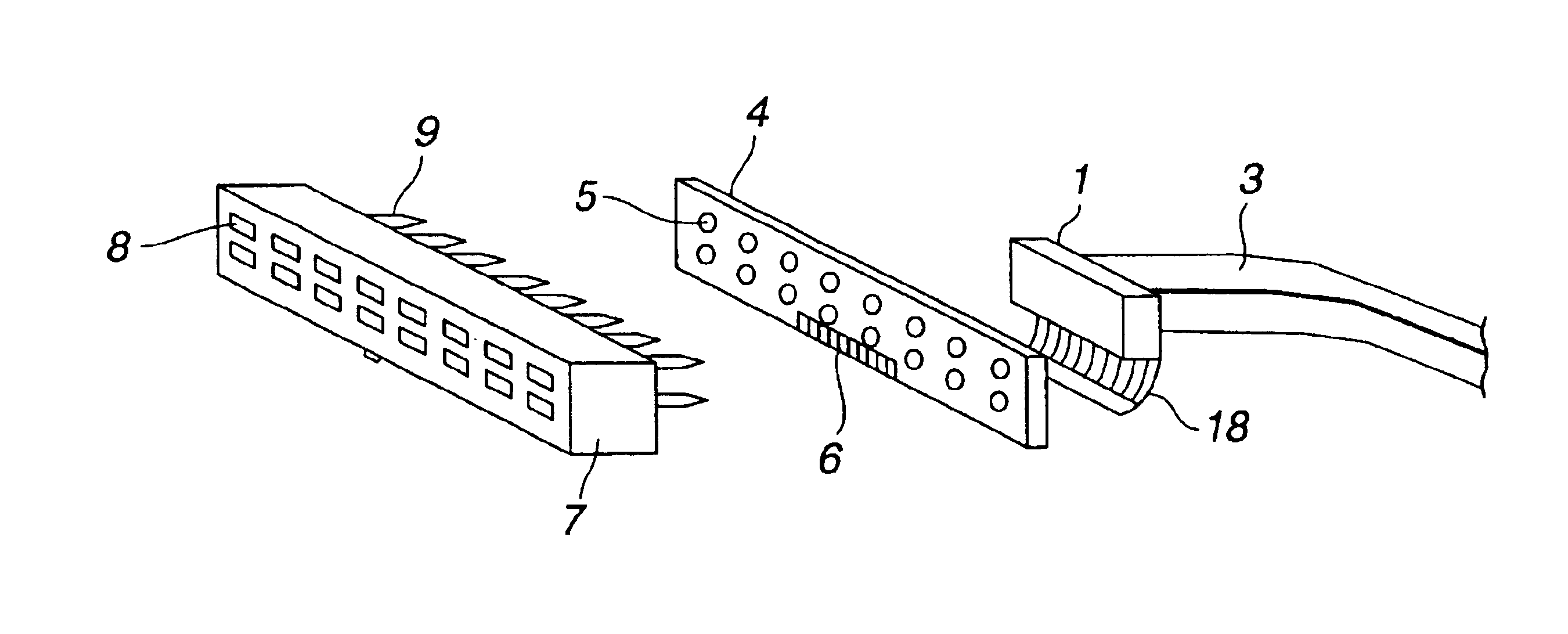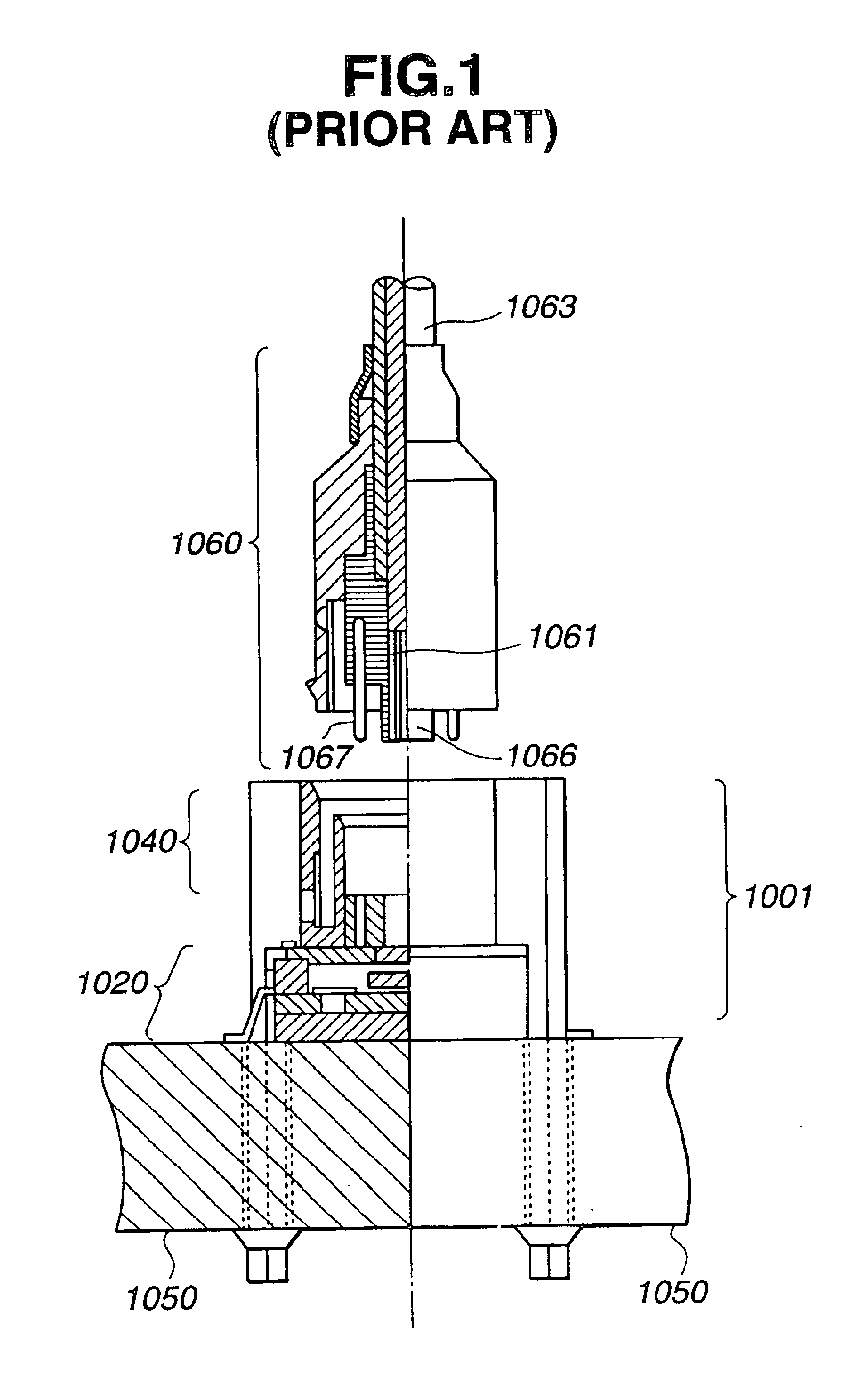Optical wiring device
a wiring device and optical technology, applied in the field of optical wiring devices, can solve the problems of signal delay, heat generation and electromagnetic radiation emission noise (emi) due to electric wiring, and the solution of those problems is difficult, and the limitations of electric wiring will be a serious problem, so as to achieve the effect of reducing cost and being adaptabl
- Summary
- Abstract
- Description
- Claims
- Application Information
AI Technical Summary
Benefits of technology
Problems solved by technology
Method used
Image
Examples
first embodiment
(First Embodiment)
FIG. 3A illustrates structures of electric and optical connecting portions of a first embodiment of the present invention directed to an optical wiring device. In the optical wiring device of FIG. 3A, a connecting portion 7 for electric connection is provided, and the electric connecting portion 7 includes a recessed electric coupler of two-dimensionally arranged recesses 8 and two-dimensionally arranged pins 9 for electrically connecting the corresponding recesses 8 to rear-stage electric wires. The connecting portion 7 is composed of a conventional resin, for example. There are sixteen (16=2×8) pins 9 in the structure of FIG. 3A, but the number thereof is not limited to this configuration. The recesses 8 may be replaced by protruding pins.
At the rear of the connecting portion 7, there is provided a plate 4 including two-dimensionally arranged holes 5, serially arranged electrode pads 6, and a wiring pattern (not shown) for electrically connecting each hole 5 to e...
second embodiment
(Second Embodiment)
The first embodiment is directed to an optical wiring device which is principally used for parallel wiring. In this case, as the number of pins increases, the area occupied by the connecting portion and the volume of the multi-core waveguide also increase.
In the light of such a disadvantage, a second embodiment is directed to an optical wiring device in which parallel-to-serial conversion is partially conducted to decrease the number of pins and the features of the surface optical device (i.e., high-speed transmission) are utilized. In the second embodiment, a connecting pin 91 is fixed to a base plate 90 as illustrated in FIG. 11A. The protruding pin 91 is connected to a board 100 through a recessed receptacle 98 mounted to the board 100 as illustrated in FIG. 11B, or directly bonded to the board 100 with a solder 103. At the rear of the base plate 90, there is provided a bare chip 92 of a Si-IC in which a parallel-to-serial conversion IC and a laser-driving IC a...
third embodiment
(Third Embodiment)
In the first and second embodiments, the multi-core waveguide fabricated by the surface process is used as the optical cable. However, when the length of the wiring between apparatuses, for example, is over 1 m, the structure using an optical fiber is more advantageous in a total cost. Therefore, in a third embodiment, an optical wiring connector is constructed by using a fiber array.
FIG. 14 illustrates the structure of the third embodiment. As illustrated in FIG. 14, pins 121 for electric connection are arranged on an electric connecting portion 120, and a Si-IC 122 is implemented on the connecting portion 120 in a flip-chip manner such that the Si-IC 122 is connected to the pins 121.
In the Si-IC 122, similarly to the second embodiment, driving ICs for the surface emitting laser and the surface light receiving device are integrated. The Si-IC 122 has a region for the implementation of optical devices 123 and electrode pads, similarly to the second embodiment. The ...
PUM
 Login to View More
Login to View More Abstract
Description
Claims
Application Information
 Login to View More
Login to View More - R&D
- Intellectual Property
- Life Sciences
- Materials
- Tech Scout
- Unparalleled Data Quality
- Higher Quality Content
- 60% Fewer Hallucinations
Browse by: Latest US Patents, China's latest patents, Technical Efficacy Thesaurus, Application Domain, Technology Topic, Popular Technical Reports.
© 2025 PatSnap. All rights reserved.Legal|Privacy policy|Modern Slavery Act Transparency Statement|Sitemap|About US| Contact US: help@patsnap.com



